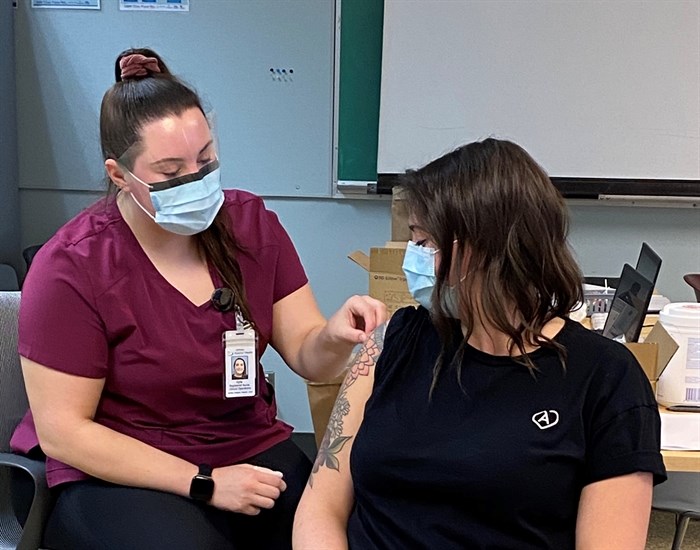
Kelsey Medhurst was the first COVID-19 vaccine recipient in Kamloops.
Image Credit: SUBMITTED/Interior Health
December 23, 2020 - 4:44 PM
While the Moderna COVID-19 vaccine has been approved for Canada and will arrive in B.C. as early as Monday, it will take many weeks for the average person to qualify for an injection.
By March, B.C. is expecting to get 792,000 doses of the Pfizer and Moderna vaccines, provincial health officer Dr. Bonnie Henry said during a news conference today, Dec. 23.
Each vaccination requires two doses. While manufacturers recommend the second dose be administered 28 days after the first, B.C. is going to give the second dose after 35 days, in order to increase the number of people who can be vaccinated with the limited supply.
That means 549,000 people can get a vaccination by March and 240,000 will have a second dose.
The vaccine is 80 per cent effective for the first dose and 95 per cent after the second one, Dr. Henry said.
From now to the end of January, the priority will be to vaccinate residents and staff in long-term care homes, which is about 70,000 people.
Next up will be residents and staff in assisted living facilities then people in hospital waiting for a bed in long term care, essential visitors and health care workers who are key to the COVID response and to protect the health care system.
“Our two key aims right now are to save lives by providing protection to those who are most at risk and taking the pressure off our health care system so that we’re able to provide safe health services to everybody in the province through these very stressful next few months,” Dr. Henry said.
Ten remote and isolated First Nations communities are also high on the priority list for receiving the vaccine.
By February, the vaccine may be able to move out into the community.
“As we get more vaccine and, as we’re able to protect more populations, we’ll be moving out from there to other priority populations,” Dr. Henry said.
At the top of that list will be seniors over 80 and the homeless living in shelters and group homes who, she said, are more likely to end up with serious symptoms and needing hospitalization, which puts pressure on the health care system.
Next up are people who receive long term home support, the rest of hospital staff “who are integral to our system” and additional people who are at risk in indigenous communities.
From there, as more vaccine becomes available, it’s likely that people will be vaccinated by age group, in descending five-year groupings. Those in each age group with underlying health conditions will, hopefully, get vaccinated first, she said.
To contact a reporter for this story, email Rob Munro or call 250-808-0143 or email the editor. You can also submit photos, videos or news tips to the newsroom and be entered to win a monthly prize draw.
We welcome your comments and opinions on our stories but play nice. We won't censor or delete comments unless they contain off-topic statements or links, unnecessary vulgarity, false facts, spam or obviously fake profiles. If you have any concerns about what you see in comments, email the editor in the link above.
News from © iNFOnews, 2020